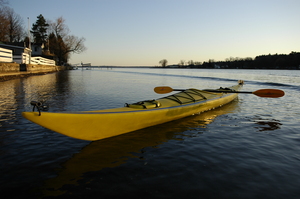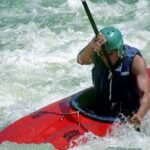Santa Cruz County’s Pleasure Point surfing area was the setting for the latest California shark attack on a kayaker, KSDK Channel 5 reports. Are kayakers in danger of experiencing more shark attacks as the sport becomes more popular?
What are the details of the shark attack?
A fish believed to be a great white shark attacked a kayaker at 8:30 a.m. on Saturday. The kayak measured 13 feet in length and was attacked about a quarter mile off shore, where the ocean reached depths of 40 feet. The kayaker was not injured.
Have there been other shark attacks on California kayakers recently?
The San Luis Obispo Tribune reported in May on another shark attack off California’s shoreline. A kayaking angler near Moonstone Beach’s Leffingwell Landing was thrown from his kayak when a 12- to 14-foot shark attacked. The kayaker did not receive any injuries.
Where do most human interactions with sharks occur off the California coast?
The Florida Museum of Natural History maintains the international shark attack file, which places California’s shark attacks — between 1926 and 2011 — at 104 unprovoked hits. Nine shark attacks were fatal. The greatest numbers of shark attacks occur near the counties of San Diego, Humboldt, Marin and Monterey. The lowest numbers were recorded around the counties of San Francisco, Los Angeles, Del Norte, Orange, Mendocino and Alameda. Moderate attack numbers were recorded for the coastlines along the counties of San Mateo, Santa Cruz, Santa Barbara, San Luis Obispo and Sonoma.
Is kayaking getting more dangerous off the California coast?
The Shark Research Committee noted that of 108 authenticated shark attacks, 5 percent targeted kayakers. The majority of shark hits occurred during the daylight hours between August and October. That said, researchers point to kayakers’ abilities to cover a lot of distance during an outing, even during nighttime. With the increasing popularity of ocean kayaking clubs and the growing trend toward “moonlight” excursions — reminiscent of horseback riding under the stars — an attack by a White Shark against a kayak after sunset would seem to be only a matter of time,” they warn. The Peninsula Press echoed this concern in 2011, when it noted a trend of increased shark attacks and placed California in a third place tie for these encounters. (The other contenders were Hawaii and South Carolina.) Noting that two out of three 2011 great white attacks targeted kayakers, the increased popularity of the sport off California’s coast easily explains the phenomenon.
How should California kayakers react to the latest great white shark attacks?
You’re very safe in California water,” a shark expert from the California Academy of Sciences told the Peninsula Press. Kayakers desirous to enter waters without recent news of shark activity should look to the Shark Research Committee, which maintains an up to date Pacific Coast Shark News site. There kayakers find reports of sightings — not just attacks — that pinpoint locations and possible destinations of sharks in California waters.
Sources
KSDK Channel 5; “Great white shark attacks kayaker in California”
San Luis Obispo Tribune; “Great white takes big bite out of kayak off Cambria”
Florida Museum of Natural History; “1926-2011 Map of California’s Confirmed Unprovoked Shark Attacks (N=104)”
Shark Research Committee; “Pacific Coast Shark Attack Statistics”
Peninsula Press; “California ties for third most shark attacks in U.S. as attacks rise worldwide”
Shark Research Committee; “Pacific Coast Shark News 2012







